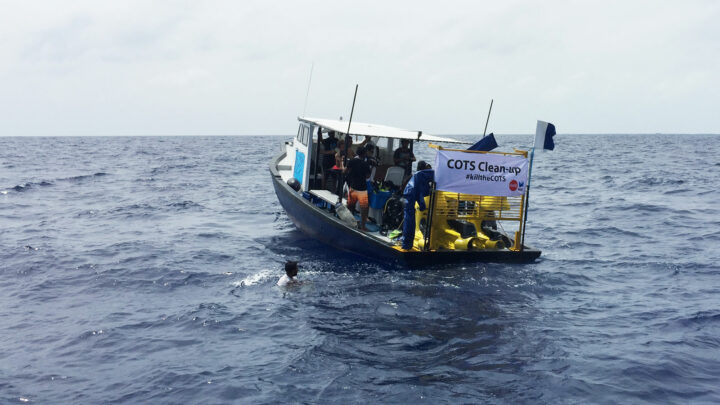
Environment: A Plague of Starfish
[vc_row][vc_column][vc_column_text]
In mid-2015, a plague of coral-devouring starfish known as crown-of-thorns posed an existential threat to coral reefs, the bedrock of the Maldives’ thousand isles.
Crown-of-thorns starfish (Acanthaster planci) or COTS is a venomous predator that feeds on polyps, the tiny creature whose calcium carbonate secretions forms coral reefs. A single starfish can consume 10 square meters of coral a year. Often exceeding one thousand per hectare during severe outbreaks, a swarm of starfish can destroy an entire reef system in weeks.
Alarmed by the mass outbreak, dive operators, environmental NGOs, and tourist establishments last year took on the laborious task of defending the Maldives’s fragile underwater ecosystem from the COTS invasion.
“On a recent COTS removal dive, divers from 10 boats removed 900 COTS from one dive site in Male’-Hulhumale’ area,” said Hussain Rasheed from the Divers Association of Maldives (DAM).
According to DAM, the starfish were first sighted in 2014. It gradually swelled in numbers and spread all over the country.
The second largest starfish in the world, COTS can grow up to 80cm wide. Using its multitude of tube feet, the starfish climbs onto a section of living coral colony, firmly attaches itself, and expands its stomach out through its mouth to virtually its own diameter. The stomach surface then secretes digestive enzymes that allow the starfish to absorb nutrients from the liquefied coral tissue, leaving a white scar of coral skeleton that is rapidly infested with filamentous algae.
The predators systematically consume every inch of living coral and then migrate to the next reef. COTS can go months without food while seeking a new feeding ground.
Named for the dense covering of sharp, venomous spines on the upper surface of its body, COTS has few natural predators. In the course of a breeding season, an adult crown-of-thorns is capable of producing 50 million eggs, leading to outbreaks under the right environmental conditions.
Last year, scientists from the US-based non-profit environmental science organisation, Khaled bin Sultan Living Oceans Foundation, visited the Maldives and worked with divers from local resorts. More than 7,000 COTS were removed as part of its on-going Starfish Control and Removal (SCAR) Programme.
“Recognising the losses that occurred in the late 1980s, marine biologists and dive centers at neighboring resorts were the first to respond. Our discussions with fishermen, biologists and resort staff suggest that tens of thousands of starfish were either removed, or injected over the preceding two years,” said Dr Andrew Bruckner, Chief Scientist of the Khaled bin Sultan Living Oceans Foundation.
However, he added, the commendable effort was not enough to save many doomed coral reefs.
“Some of the flourishing house reefs, wrecks and other sites frequented by the dive centers are now devoid of coral, and the plague of starfish continues to threaten the viability of the remaining reefs,” he said.[/vc_column_text][vc_gallery interval=”5″ images=”10568,10569,10570,10571″ img_size=”full”][vc_column_text]Though labour-intensive and dangerous, the most common method for eliminating COTS is manually removing individual starfish with a pick or tong and burying them deep on land.
“This process can be dangerous, as the starfish are covered in highly toxic spines and care is needed during collection, bagging and transport,” cautioned Dr Bruckner’s report.
“Furthermore, disposal can present its own set of challenges. Because COTS contain high amounts of water within their bodies, it is difficult to incinerate large amounts of COTS at one time. The alternative, disposal in landfill, is also problematic due to the odor of rotting starfish.”
Although evidence suggests that outbreaks have occurred relatively regularly for thousands of years, their frequency and severity appears to be worsening in recent decades.
According to Dr Bruckner, there was only one previous documented outbreak in the Maldives.
“It started in 1988, in the vicinity of Reethi Rah, and followed a similar pattern of spread with subsequent outbreaks appearing over the next 3-4 years on other atolls. After high levels of destruction, the starfish disappeared, and reefs slowly rebounded,” he said.
As to the cause of these outbreaks, scientists are not sure. However, COTS outbreaks have been linked to an increase in phytoplankton, a necessary food source for COTS larvae. Elevated nutrient levels from agricultural land run-off may lead to phytoplankton blooms, driving the development and survival of the starfish.
Some scientists believe that crown-of-thorns outbreaks are linked to the timing of El Niño events – mass coral bleaching due to higher ocean temperatures – while others believe that outbreaks are driven by human activity, such as overfishing and the removal of COTS predators like the giant triton snail, the humphead wrasse, starry pufferfish and titan trigger.
While COTS outbreaks cannot be prevented entirely, the Khaled bin Sultan Living Oceans Foundation suggests that “localised efforts to irradiate the species have proven to be successful at preventing a reef from being decimated by COTS and maintaining the health and resiliency of the coral reef.”
The Maldives’ chain of 1,192 islands would erode and wash away without the fragile ecosystem of coral reefs. Without corals, the fish that depend on reefs for feeding, shelter and breeding grounds will disappear. If the infestation is not checked and arrested, the plague of starfish could cripple the Maldives’s environment-dependent tourism and fisheries industries.[/vc_column_text][/vc_column][/vc_row]





